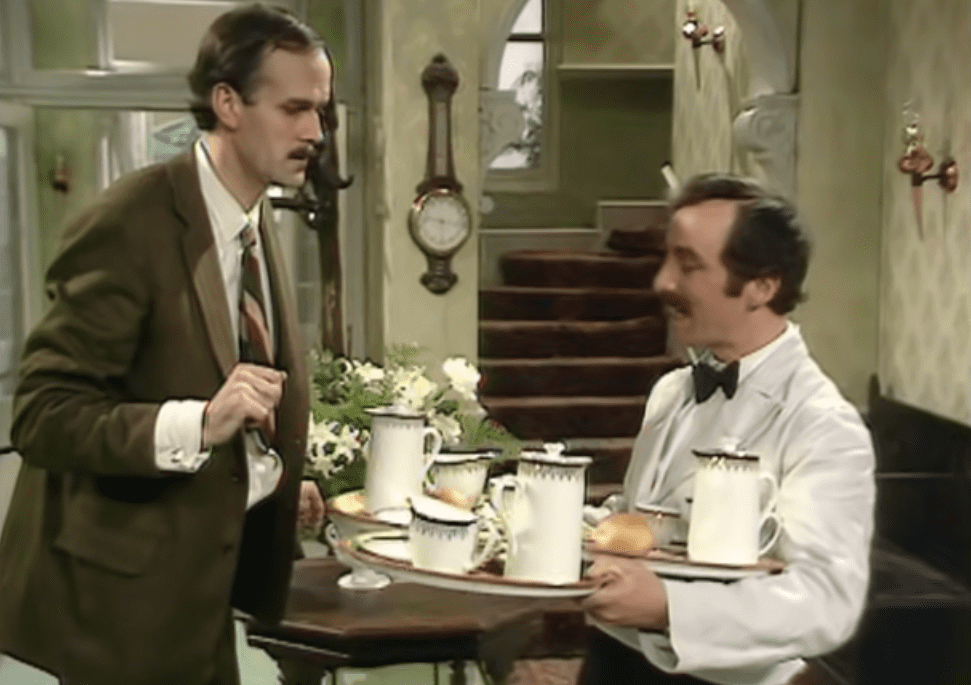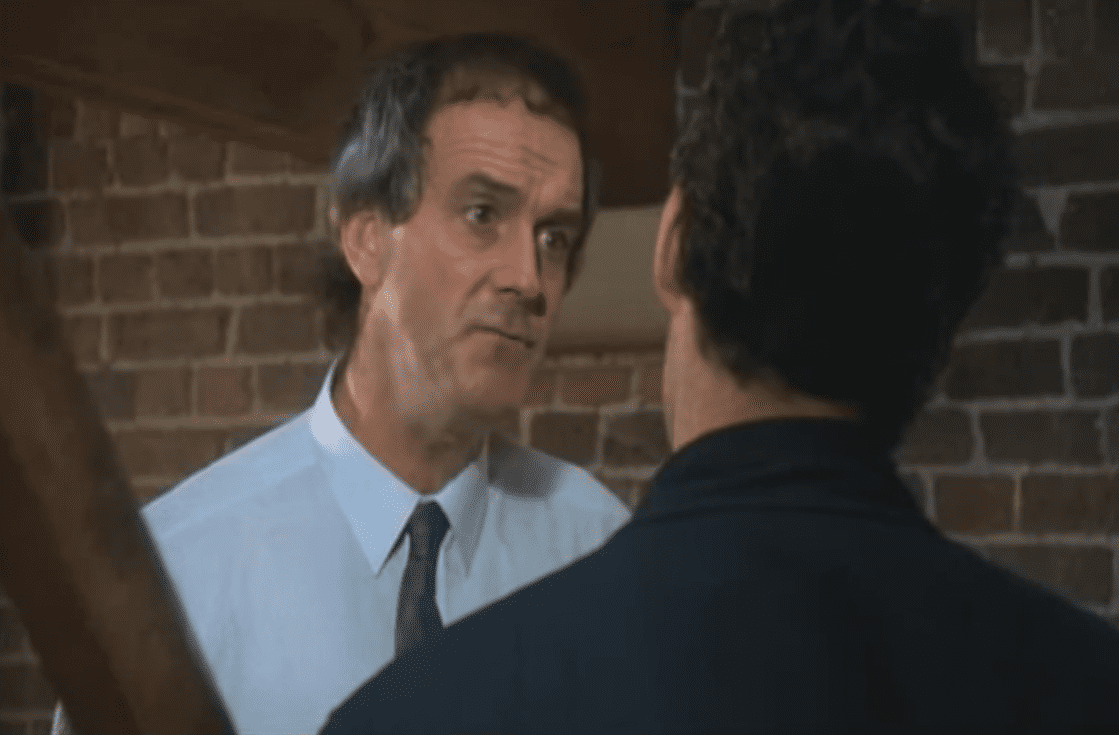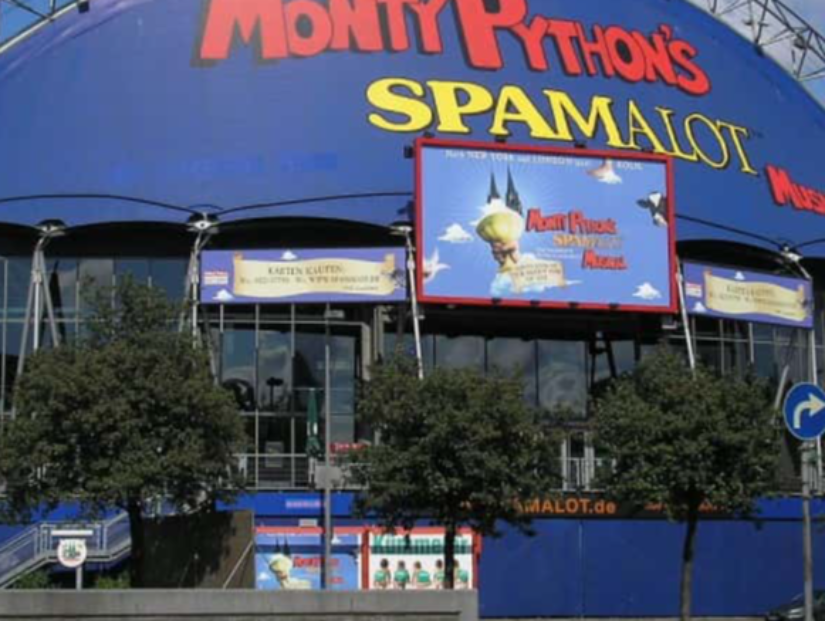“This parrot is no more! It has ceased to be! It’s expired and gone to meet its maker! This is a late parrot! It’s a stiff! Bereft of life, it rests in peace! If you hadn’t nailed it to the perch, it would be pushing up the daisies! It’s run down the curtain and joined the choir invisible! This is an ex-parrot!”—John Cleese, Monty Python's Flying Circus
What other comedy team is as universally familiar and popular as Monty Python? It's no surprise that this classic British group has had a major, consistent presence in movies, TV, and the stage in some form or another for close to 50 years. And even if they're not on screen, just ask about any comedian from the later 20th century and they'll tell you just how important and influential Python was. Here are 42 hilarious facts about this group of six brits who took the world by storm and changed comedy forever. Oh, and they were pretty funny too.
1. Party of Six
For the uninitiated, the first fact to know is that Monty Python is not just the eccentric name of an extremely multifaceted comedian. Python was a comedy sketch troupe consisting of six members: John Cleese, Graham Chapman, Eric Idle, Terry Jones and Michael Palin performed in the group's sketches and films, while Terry Gilliam's iconic animation style provided the backdrop.

2. Something Completely Different
The catchphrase from the TV series Monty Python's Flying Circus became the title of their 1971 feature film: And Now For Something Completely Different, which was basically a 90 minute montage of the show's most popular sketches. That may seem a little redundant, but it was intended to be a showcase for Americans who had never really seen the show before. The movie had such a low budget that some of the effects that had been featured on the TV show were too expensive to be put in the movie.
 And Now for Something Completely Different (1971), Columbia Pictures
And Now for Something Completely Different (1971), Columbia Pictures
3. Artistic Expression
Members of the group have said that they were able to express themselves freely for most of their show's run, which allowed the controversial and groundbreaking material they got away with to be possible. However, as the show continued, the BBC began to censor more heavily, leading to some awkward edits and impassioned battles between performers and production staff.
4. Where It All Began
A couple years prior to the comedy troupe's debut, two of its future stars, John Cleese and Graham Chapman, starred in another sketch-comedy TV series in which many future Monty Python sketches and ideas were developed. Despite airing in 1967, the show was titled At Last the 1948 Show.
 At Last the 1948 Show (1967), ITV
At Last the 1948 Show (1967), ITV
5. Another Preview
At Last the 1948 Show was not the only time prior to the formation of Monty Python that a bunch of future members would work together. The TV broadcast titled How to Irritate People was produced in 1968 and is seen as an obvious forerunner to the series we would all come to know and love just one year later. This time, Michael Palin starred along with Cleese, Chapman, and the rest of the gang from At Last.
 How to Irritate People (1968), David Paradine Productions
How to Irritate People (1968), David Paradine Productions
6. Blue (Blood) Comedy
Given the silliness and absurdity of Monty Python's comedy, the last thing one might relate them to is a stiff, academic setting. Yet surprisingly, several of the members first met one another while attending some of England's top universities—Jones and Palin met at Oxford, while Cleese and Chapman met at Cambridge. Idle, for his part, also attended Cambridge, but he wasn't in the same year as Cleese and Chapman. Nothing says "Upper Crust British University" like Monty Python, apparently.
7. Left, Right, Left, Right!
Despite being a purely British production, the group chose the Liberty Bell March, a composition by American March King John Phillip Sousa, as its theme song because there were no royalty feels required. And who doesn't like a little Sousa, seriously!
8. Respect Your Elders
John Cleese is the oldest member of the troupe, born in 1939. You can tell by his always mature and dignified manner...
9. The Black Sheep
Terry Gilliam is the only member of the troupe who was born and raised outside of the United Kingdom. Gilliam was born in Minnesota and attended university at Occidental College in LA before making the move across the Atlantic. He became a British citizen in 1968 and renounced his American citizenship in 2006.

History's most fascinating stories and darkest secrets, delivered to your inbox daily.
10. Personal Prop
The late Graham Chapman is said to have rarely been seen without his trademark pipe either in his hand or in his mouth.
11. This is an Ex-Parrot!!
During John Cleese's memorable rant to the pet shop owner in the “-Gone Parrot” sketch, he uses 16 distinct terms and phrases to express make his opinion—that the parrot is gone—clear. Among these synonyms are “perished,” “demised,” “expired,” “bereft of life,” “pushing up the daisies,” and “gone to meet its maker". Maybe if comedy hadn't worked out, Cleese could have made it big writing thesauruses!
 Monty Python's Flying Circus (1969-1974), BBC One
Monty Python's Flying Circus (1969-1974), BBC One
12. Out of Towner
While most members of the team hail from England, Terry Jones is from a little farther west. Jones was born in Colwyn Bay, a town on the Northern coast of Wales. To his credit, he wasn't from as far west as Gilliam.
13. The Circus Leaves Town
The original Monty Python's Flying Circus TV series ran for just four years, totaling 45 episodes, making its tremendous impact all the more amazing.
14. Leading Lady
If there's anyone who could count as the seventh Monty Python star, it would have to be Connie Booth. Aside from appearing regularly in sketches on Flying Circus, Booth appeared in multiple Monty Python films, the How to Irritate People TV special, and John Cleese's Fawlty Towers. Oh, and she was also married to John Cleese in real life. It's hard to imagine what Monty Python would have looked like without Connie Booth involved in some way.
 Fawlty Towers (1975-1979), BBC Worldwide
Fawlty Towers (1975-1979), BBC Worldwide
15. Breaking Up is Hard to Do
Since splitting up with co-star Connie Booth, John Cleese has been married three more times. Most recently, he married his current wife Jennifer Wade in 2012.
16. The Silver Screen
In addition to the TV show, Monty Python is well-known for their four feature films: And Now For Something Completely Different and The Meaning of Life were essentially long-form versions of the TV show, each featuring a series of unconnected sketches, while Monty Python and the Holy Grail and Life of Brian both had coherent (well, as coherent as Python wanted to be) storylines.
17. Rutlemania
Back in the 1970s, Eric Idle created a Beatles-parody group called the Rutles which became so popular that two of their songs became hits and actually charted in the UK. Even actual Beatle George Harrison was into it, and he appeared in the group's mockumentary film.
18. Original Art
Terry Gilliam's animation was a unique and integral part of Monty Python's aesthetic. While he was originally credited as an animator, separate from the rest of the group, he eventually got recognized as a full-fledged Python. He also played several small parts in various Python works, perhaps most famously as Patsy, King Arthur's "horse" in Holy Grail. It's only a model...
 Monty Python and the Holy Grail (1975), EMI Films
Monty Python and the Holy Grail (1975), EMI Films
19. Pythonesque
The influence of Monty Python has been so enormous that a word describing their style of humor has made it into the English dictionary. "Pythonesque" is defined as “Denoting or resembling the absurdist or surrealist humour or style of Monty Python's Flying Circus, a British television comedy series". And when you have a word named after you, odds are you've seriously accomplished something.
20. Rumor Has It
Back in the early 2000s, there was an internet rumor claiming a Japanese-English phrasebook had been produced with deliberately incorrect translations as a practical joke to get unsuspecting tourists in trouble, exactly like the Monty Python “Hungarian Phrasebook” sketch. Fortunately (or unfortunately?), Snopes and other websites have indicated that the story appears to have been nothing more than a case of mistaken reporting. Lucky for those tourists, no one was led to tell people their “hovercraft is full of eels”!
21. A Previous Life
Prior to getting involved with Monty Python and other comedic endeavours, John Cleese had briefly worked as a teacher. I can't imagine I would learn a whole lot in that class, but I bet it would be fun!
22. Around the World
Michael Palin is an avid globe trotter, becoming an acclaimed travel writer after Monty Python broke up. In total, he has written 21 books and hosted many travel documentaries, including one in 2007 called Michael Palin's New Europe in which he explores countries and territories in Eastern Europe which had formerly been off limits due to the Soviet Iron Curtain.
23. Second Hit
John Cleese is certainly not only known for his work with Monty Python. He wrote and starred in the British 1970s mega-hit Fawlty Towers, a 12-episode sitcom in which he played an easily frustrated hotel manager trying to cope with difficult guests and staff. Towers was so popular that it ranked first on the British Film Institute's 2000 list of the “100 Greatest British Television Programmes". Can't get much better than that!
 Fawlty Towers (1975-1979), BBC Worldwide
Fawlty Towers (1975-1979), BBC Worldwide
24. Unsung Talent
While not performing comedy, Terry Jones is an expert on the Middle Ages and has even written books and produced TV shows about the era. In all, Jones has written a staggering 29 books, both fiction and non-fiction. And here I'm thinking that Python was enough!
25. Just Like Old Times
John Cleese made headlines recently for bringing his classic Fawlty Towers character, Basil Fawlty, back into action for the first time in 40 years... as part of a glasses commercial.
26. I Wanted To Be... a Lumberjack!
Monty Python's classic “Lumberjack Song” was apparently written from start to finish in about 15 minutes because the guys couldn't think of an ending for the sketch they had been writing. 15 minutes well spent, I'd say.
27. “It's Just a Flesh Wound!”
You may remember seeing Eric Idle make an unforgettable cameo appearance in National Lampoon's European Vacation, playing the overly polite Bike Rider who gets hit by a car. This bit was so popular, it was revived for a 2003 made-for-television sequel, with Idle playing a similar character, except on a plane.
28. Joining the Show
Kim “Howard” Johnson is a Monty Python "superfan" who has authored several books about the troupe. In 1982, his dedication was repaid when he was given the opportunity to appear as an extra in the group's Live at the Hollywood Bowl show.
29. Getting Around
The silly walk performed by John Cleese in the “Ministry of Silly Walks” sketch was turned into an endless runner game for mobile platforms, with an animated Cleese performing his ridiculous gait. The developers even got Cleese to provide some voice work!
30. Beyond the Scope of Comedy
The definition of an argument offered by Michael Palin's character in the “Argument Clinic” sketch, "An argument is a connected series of statements intended to establish a definite proposition," was pulled nearly word-for-word from the Oxford English Dictionary. And you thought it was just a joke!
31. Reunited
Former Pythonmates John Cleese and Michael Palin were reunited to star in the popular award-winning 1988 comedy film A Fish Called Wanda—a film that was written by Cleese himself. The film was a critical success and was nominated for three Academy Awards, including a Best Original Screenplay nom for Cleese. He didn't win, but Kevin Kline ended up taking home the Best Supporting Actor statue.
 A Fish Called Wanda (1988), MGM
A Fish Called Wanda (1988), MGM
32. What About a Pointed Stick??
The classic “Self-Defense Against Fresh Fruit” sketch was channeled in a 2016 Nikon promotional video in which a man punches and kicks various food items to illustrate a camera's intricate ability to capture a precise moment. And those Pythons thought those fruit-fighting skills would never come in handy! Just don't try coming at them with a pointed stick...
 And Now for Something Completely Different (1971), Columbia Pictures
And Now for Something Completely Different (1971), Columbia Pictures
33. Luxury!
Although the “Four Yorkshiremen” sketch has appeared in several Monty Python productions, it actually originates from At Last the 1948 Show—Chapman and Cleese's pre-Python series. It was originally written by them and their At Last castmates Tim Brooke-Taylor and Marty Feldman.
34. The Quest
1975's Monty Python and the Holy Grail was arguably Monty Python's most famous film. The film was also the troupe's first attempt at creating a coherent, original story, rather than compiling a series sketches. I'd say they did pretty well, how about you?
35. Adaptation
The lasting popularity of Holy Grail is evident in the fact that it was adapted by Eric Idle into a Tony award-winning Broadway show in 2005: Monty Python's Spamalot. In it's original run, the play ran for more than 1,500 shows and was seen by more than two million people, taking home three Tonys in the process.
36. The Last Hurrah
The 1989 20th anniversary special Parrot Sketch Not Included would prove to be the last production to feature all six members, due to the passing of Graham Chapman shortly after it was made. And in case you were wondering, the "Gone Parrot Sketch" was, in fact, not included in the special.
37. Frustration Creates Comedy
Few Monty Python routines are as beloved as the classic “Gone Parrot” sketch, in which a pet shop clerk tries to convince an angry customer that the bird he was sold is not gone, but resting. The inspiration for this sketch was a real life incident in which Michael Palin met a stubborn car salesman who denied that his car had any problems. Maybe his car was also merely “stunned” or “pining for the Fjords”!
 PalFest, CC BY 2.0, Wikimedia Commons
PalFest, CC BY 2.0, Wikimedia Commons
38. He Loved Them, Yea Yea Yea
As alluded to earlier, Beatles guitarist and singer George Harrison was a big Monty Python fan and friend. In addition to his support for Rutlemania, he also stepped in to fund and produce the team's 1979 film Life of Brian and even made an uncredited cameo.
39. Getting Schooled
Does anything strike you as educational about the “Dirty Fork” sketch, in which a restaurant patron is berated by several employees for asking to get a cleaner fork than the one he was given? It turns out this sketch is actually offered as part of the Key Stage 2 National School Curriculum in England to teach conflict resolution. How about that?
 Monty Python's Flying Circus (1969-1974), BBC One
Monty Python's Flying Circus (1969-1974), BBC One
40. World Record
In addition to the many awards and honors for the group's comedy efforts, Monty Python holds a surprising world record; in 2007, Jones and Gilliam led the Spamalot cast and fans in setting the record for largest "coconut orchestra" of all time. The group, totalling 5,567 people, made it into the Guinness Book of World Records—smashing the previous record of 1,789. Forget everything else, this is going to be Python's legacy!
41. The Sad Part
Even comedians are human beings who have to face and deal with the same real problems as anyone else. Sadly, Terry Jones is currently suffering from dementia, and we can join his fans in hoping that he will keep well during this challenging and tragic process. His difficulties first came to light during a series of Monty Python shows in 2014 where he was having trouble remembering his lines, eventually resorting to using a teleprompter. Sadly, he passed on in 2020.
42. Resting in Peace?
All of the Monty Python members are still alive with the exception of Graham Chapman, who passed in 1989, and recently, Terry Jones, who passed in 2020. In typical absurd and outrageous Monty Python style, Cleese, Palin and Idle all gave humorous eulogies at Chapman's funeral. Highlights from the day included when Cleese became the first person to say the "F" word during a televised British memorial service, saying Chapman would have wanted him to, and when everyone in attendance joined together in singing "Always Look on the Bright Side of Life". Later, the group appeared to accidentally knock over and spill their late colleague's ashes as a joke in their 1998 reunion show Monty Python Live at Aspen.
Sources: 1, 2, 3, 4, 5, 6, 7, 8, 9, 10, 11, 12, 13, 14, 15, 16, 17, 18, 19, 20, 21, 23, 24, 25, 26, 27, 28, 29, 30, 31, 32, 33, 34









































